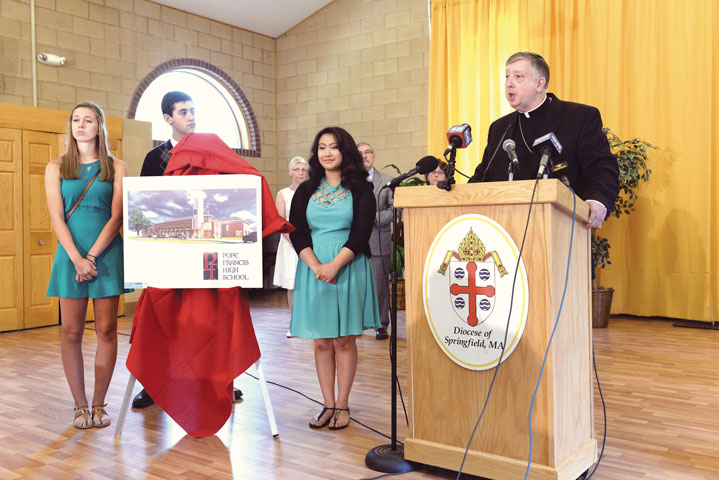
Bishop Mitchell Rozanski of Springfield, Mass., announces the new Pope Francis High School June 19. An artist's drawing of the new school is posted at left with three high school students. (The Republican/Mark M. Murray)
Springfield's Cathedral High School might have endured a quiet demise had it not been for the tornado. A funnel of wind roared through Massachusetts' third-largest city on a June afternoon in 2011, ripping the walls off Cathedral's science wing and flinging cars into a nearby pond, putting the once prestigious, now declining diocesan high school suddenly on the radar of City Hall, the Chamber of Commerce, as well as the bishop.
Since the tornado, the Catholic high school remained temporarily housed in a school in the nearby town of Wilbraham, awaiting the diocese's decision to close or continue.
On June 19, Springfield Bishop Mitchell Rozanski announced that Cathedral, now being merged with Holyoke Catholic High School* of nearby Chicopee, Mass., will be rebuilt at the site of the old Cathedral school on Surrey Road. Students from both schools voted in May to name the new regional school Pope Francis High School.
It has taken four years, but the dream of the community to keep the Catholic high school will finally be realized.
Springfield's fight for Cathedral had been brewing for months. The battle reached a fever pitch last winter after Rozanski initiated a collaborative review process to discern if the high school, which had been bleeding students for decades, was sustainable. Protracted wrangling over the insurance settlement initially stalled the school's renovation. (The diocese was eventually awarded $50 million for all its storm-damaged properties.)
The city had been patient. In March 2014, U.S. Rep. Richard E. Neal (D-Mass.), a former Cathedral teacher, procured federal emergency management funds for rebuilding the school to ensure it would stay in the city for "generations to come."
"The history of Springfield and Cathedral are intertwined, and it is hard to imagine one without the other," Neal said. The funds prompted Bishop Timothy McDonnell, then head of the diocese, to declare the school's reconstruction would begin.
But Rozanski, McDonnell's successor installed in August 2014, put the brakes on the project. His call for re-evaluation prompted an outcry from the city. Springfield Mayor Domenic Sarno promised to "fight tooth and nail" for the Catholic high school.
The Committee for Cathedral Action, an ad hoc group formed in the fall of 2013, launched the equivalent of a political campaign to persuade the bishop to keep the school. "Save Cathedral" yard signs and bumper stickers appeared everywhere. Weekly rosaries were held in front of the school's boarded-up buildings.
In December, Neal, Sarno, several city councilors, and Springfield's popular sheriff rallied with 300 of the high school's supporters on the steps of city hall. The band from Springfield High School of Science and Technology played the Cathedral fight song. St. Joseph Sr. Joyce Wise offered prayers.
When the crowd was asked "Can we rebuild Cathedral High?", the response was a resounding "Yes, we can!"
The school's merger only partially mollified Springfield's elected officials. Grateful the beloved high school would continue, albeit in different form, they were quick to express "extreme disappointment" with delays in its reconstruction.
"Noah and his family built the ark faster than we have been able to rebuild Cathedral High School," said Springfield Councilor Timothy Rooke. "And they didn't have insurance and FEMA money."
Locals are quick to point out that Cathedral is a "Springfield institution." Established during Springfield's manufacturing heyday, its fortunes parallel this once bustling, now financially struggling city.
For the sake of the school. For the sake of the city. For the sake of the church. Springfield's fight to save Cathedral High is a fascinating tale that reveals much about the vulnerability and value of an urban Catholic school.
For the sake of the school
Springfield's first bishop, Patrick O'Reilly, established the school in 1883. At his request, 10 Sisters of St. Joseph came up from Brooklyn, N.Y., to educate the children of Catholic immigrants pouring into the city because of an abundance in manufacturing jobs. The first high school students were instructed in two storerooms above the altar at St. Michael's Cathedral downtown.
By the mid-1940s, enrollment was so high that the nuns taught two sessions a day to accommodate the freshman class. In 1959, the rapidly expanding school was relocated to Surrey Road in the suburban neighborhood of East Forest Park, where the diocese built a $5 million state-of-the-art facility.
Cathedral soon became the largest Catholic school in New England, boasting nearly 3,000 students. Known for its academic and athletic achievements, it was recognized by President Ronald Reagan in 1984 as one of 60 outstanding high schools in the country.
By the mid-1990s, the school began to suffer from a vicious cycle of declining enrollment and escalating tuition. Springfield was no longer a city rich in jobs or in nuns available to teach at low cost. New charter schools offered parents more choices for free education. The closure of an air base in nearby Chicopee deprived the Catholic high school of an important feeder population.
Between 2004 and 2012, enrollment dropped from 800 students to 340. Tuition during the same period increased from $5,900 to $9,300, an unreachable sum for many residents in this city, where median income is $35,000.
Various factors influenced the decline, according to analysis by the Cathedral board of trustees. The 2004 indictment of Springfield Bishop Thomas Dupre on two charges of child rape was followed by a small dip, as was a fire in the gym in 2006 that affected the athletics program.
But the hardest blows, by far, were economic and climatic. Cathedral's most dramatic decrease in students came after the national financial crisis of 2008 and the 2011 tornado.
"We could not stop the bleeding," said St. Joseph Sr. Denise Granger, school principal from 1993 to 2004. During Granger's administration, Cathedral established a board of trustees comprised primarily of alumni recruited for their expertise in financing and marketing. It was the first of several organizational changes made in response to the financial challenges of running a diocesan high school.
"Education is very expensive to deliver, whether there are 14 students or 30 in the room," Granger said.
To "solicit the best thinking" on what to do about the tornado-stricken school, Rozanski initiated a review process within two months of his installation. The diocese surveyed parents and alumni via email, met with stakeholder groups, then in late January 2015 held a weekend session of problem-solving workshops with representatives from each group.
"It may surprise some to know that there have been many who have cautioned me to proceed carefully, given the economic realities of our area, our diocese, and the current diminishing enrollment in all our Catholic Schools," Rozanski wrote in a Nov. 6, 2014, letter to the diocese. "I am very conscious that whatever decision I am called upon to make will have long-term ramifications for the entire Church of Springfield."
In a televised address given in mid-January, the bishop was more pointed about the diocese's financial woes. While he recognized that Catholic education, and Cathedral in particular, had played an important role in the diocese and church, he said that supporting them had taken up "a larger and larger portion of our increasingly limited resources. It is a situation which I must be completely honest with you, is no longer sustainable."
The diocese posted on its website data about the school's finances and enrollment trends, along with notes from the stakeholders' meetings.
Summaries of those sessions revealed myriad concerns. Cathedral parents and faculty were impatient for the school to be rebuilt, as was the neighborhood group from Surrey Road. The diocese's Office of Planning and its School Board worried about future financing. Local priests wondered about spending so much money on so few. The Sisters of St. Joseph asked how the new school would reach out to the poor.
Everyone said the diocese needed to articulate its vision for Catholic education.
As unpopular as it was, the call for re-evaluation was wise, said Granger. Even those eager to have the school back in the city agreed.
"If I were president of a company and told my predecessor wants to build something, I would do the same," Rooke said.
The trouble was timing. The bishop had pushed the pause button on a project that had been a worrisome question mark for several years and now seemed ready to go. The insurance money was finally awarded. The $29 million in FEMA funds were expected to cover much of the $38.5 million cost for the school's reconstruction, and the newly established tuition assistance endowment fund had $4.4 million in pledges and pre-existing scholarships, nearly half its targeted goal of $10 million.
"There was a real erosion of confidence the diocese would do this," Granger said.
For the sake of the city
Cathedral's most vigorous asset is its alumni. The school, whose motto is "developing tomorrow's leaders," has graduates heavily represented in leadership positions.
In April, 18 famous Cathedral alumni, including New York Yankees pitcher Chris Capuano and Hall of Fame football linebacker Nick Buoniconti, released a statement to The Boston Globe, urging the Springfield diocese to locate its new regional Catholic high school on Surrey Road.
But it was the Cathedral footprint on local leadership that most influenced Springfield's fight for the high school. State Rep. Angelo Puppolo, Hampden County Sheriff Michael Ashe, and several city council members, including the president, attended the high school. Neal and Sarno are parents of Cathedral students.
More than nostalgia motivates these elected officials. Rebuilding the school is part of the economic development plan for Springfield, a city eager to show its ability to rebound from the tornado, said Carolyn Robbins, a reporter for MassLive.com, an online affiliate of the city's daily, The Republican. The newspaper has editorialized strongly in favor of having the school return to Surrey Road, as has the Springfield Chamber of Commerce.
Surrey Road "is the best and only location for the newly-merged Catholic high school," the Chamber of Commerce declared in a March 25 statement made a day after the announcement of Vision 2017, a program celebrating $2.8 billion in municipal development projects.
The Chamber of Commerce statement touted various efforts to revitalize Springfield's hard-hit neighborhoods. An $800 million casino was being built in the South End. New housing initiatives were underway, and a tornado-damaged elementary school, located near Cathedral, was up and running.
All the more reason for the residents of East Forest Park to have the Catholic high school back in the historic neighborhood, "a vibrant section of Springfield with a large tax base," the statement said.
The school "served as an anchor institution" for East Forest Park, a middle-class neighborhood with the highest voter turnout in the city, said Ryan McCollum, a political consultant and Cathedral alum who was hired by the Committee for Cathedral Action last fall to help with the campaign to save the school.
Elizabeth Samay said the presence of a Catholic high school in the neighborhood influenced her move into Springfield from the suburban town of East Longmeadow. A member of the East Forest Park Civic Association, Samay has been an outspoken advocate for rebuilding the school on Surrey Road, even though she is not a Catholic.
"The diocese raised questions over whether it was cost-effective, but there is more than enough money to build a state-of-the-art building that would encourage students to come," she said.
For the sake of the church
No one has tried to prove Cathedral's viability more persistently than Al DiLascia, a former executive manager of James River Corporation and an alumnus who co-founded the Committee for Cathedral Action in September 2013. The group's self-described agenda is to rebuild a new Catholic high school on Surrey Road.
DiLascia said he surveyed 21 Catholic high schools in the New England area and found thriving Catholic schools in cities poorer than Springfield.
Last fall, he proposed hosting a conference of successful Catholic high schools to exchange best practices. In advance of the stakeholders' meetings, he drafted a business plan for building and financing a new school, and has argued in numerous op-eds that with the right marketing, Cathedral could grow to 700 students and eventually become self-sustaining.
The funds and a strong local consensus are there; what is missing is the lack of commitment from the diocese, DiLascia said in February. "The process has all been based on money. There has been very little faith. Very little uplifting of the spirit."
Like DiLascia, many Cathedral advocates believe the school's significance for Springfield has more to do with assuring the future of the local church than property values. Take away the Catholic high school from the city and who will fill the pews in years to come?
Amid public pressure, Rozanski remained responsive and excruciatingly deliberative as he pleaded for time to "get it right."
In February, he appointed Paul Gagliarducci, a former public school superintendent experienced in building new schools, to chair the diocese's new Catholic Secondary School Initiative. Rozanski also hired Partners in Mission, an educational consulting firm, to assist with marketing.
The bishop acknowledged the merger meant a loss for "both the Holyoke Catholic and Cathedral communities," but he hoped everyone could take inspiration from the Sisters of St. Joseph who, in 1883, left the known for the uncertain.
"They took a leap of faith and for over 130 years that mission has continued," Rozanski said.
To create the new school, he was bringing together the "best of two great high schools," he said. After much prayer and thought, he chose Surrey Road over a Chicopee locale "because Surrey Road came to us free," he said.
That the new Catholic high school arises on the grounds of Cathedral must please Rooke. For him, the fight to save Cathedral was not political, he said.
"My belief is that religious education should be an option in cities and towns," the city councilor said. "Keeping Cathedral High School has to do with ensuring the Catholic faith in the future. The school is where my children learn the value and the benefits of Catholicism, and as they grow older, they can practice what they learned throughout their entire lives."
[Claire Schaeffer-Duffy is a longtime NCR contributor.]
*In a previous version of this story, the name of the school was incorrect.




